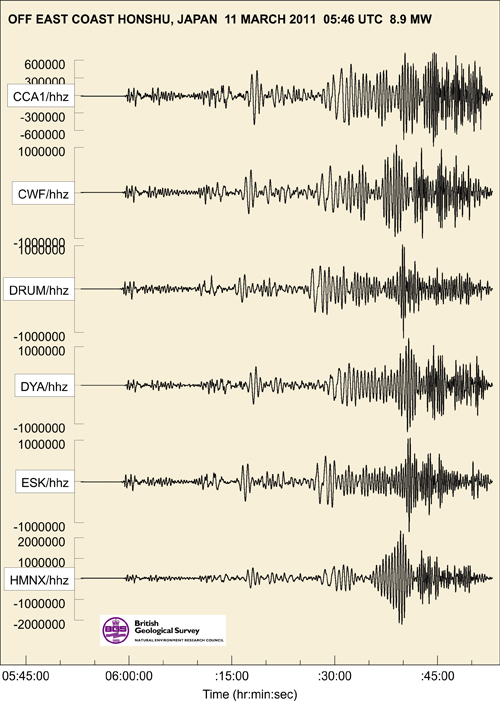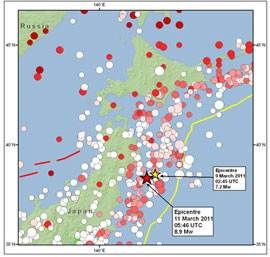Great Tohoku earthquake (Honshu, Japan) | Mag 9.0 | 11 March 2011
| Date | 11 March 2011 |
|---|---|
| Origin time | 05:46 23.0s UTC |
| Lat/Lon | 38.322° North / 142.369° East |
| Depth | 24.4 km |
| Magnitude | 9.0 Mw |
| Locality | approx 100 km from the east coast of Japan, approx 373 km north-east of Tokyo |
The magnitude 9.0 earthquake that struck Japan was the fifth largest earthquake ever recorded. The earthquake was located approximately 40 km south-west of a magnitude 7.2 event that occurred on 9 March 2011.
It was larger that the magnitude 8.8 earthquake that struck Chile in February 2010 and around a third of the size of the Sumatra earthquake of 26 December 2004. In common with both the Chile and Sumatra earthquakes, it is yet another recent example of a mega-thrust earthquake at a boundary between two of the Earth's tectonic plates.
Even in a country as used to earthquakes as Japan, the magnitude of the earthquake was unprecedented. Previously, Japan's most destructive earthquake was the magnitude 7.9 Great Kanto earthquake of 1923 that occurred south of Tokyo.
The earthquake ruptured a 400–500 km long segment of the plate boundary east of northern Honshu. The amount of slip on the interface between the two plates may have been as much as 5–10 metres. This motion would have resulted in uplift of the seafloor above the rupture zone by several metres.
Many large aftershocks have also occurred, the largest being a magnitude 7.1. The aftershock sequence is likely to continue for many months and result in many thousands of earthquakes.
Tsunami
A number of aftershocks (up to magnitude 7.1) have occurred and a tsunami warning was issued throughout the Pacific.
How frequent are these huge earthquakes?
On average, we get an earthquake of this magnitude once every ten years.
Nine events of magnitude 7 or greater since 1973 have occurred on the Japan Trench subduction zone. The largest of these was a magnitude 7.8 earthquake, approximately 260 km to the north of the March 11 event, in December 1994, which caused three fatalities and almost 700 injuries.
In June 1978, a magnitude 7.7 earthquake 35 km to the south-west of Japan caused 22 fatalities and over 400 injuries.
Key facts about the Great Tohoku earthquake:
- It is the largest in Japan, since seismology records began in 1900
- It is the equal fifth largest earthquake to occur in the world
- It is about 10 000 times bigger than the recent Christchurch earthquake
- The largest earthquake in the world was in Chile in 1960, magnitude 9.5, which was five times bigger than the Great Tohoku earthquake

- A Comparison of the Folkestone and Market Rasen Earthquakes
- Seismogenesis and State of Stress in the UK
- Monitoring Volcanic Eruptions Using Interferometry
- Particular events
- Are yesterday's earthquakes tomorrow's disasters?
- Creating 'virtual seismometers' deep inside the Earth
- Is earthquake activity related to the Moon or Sun?
- Is earthquake activity increasing?



